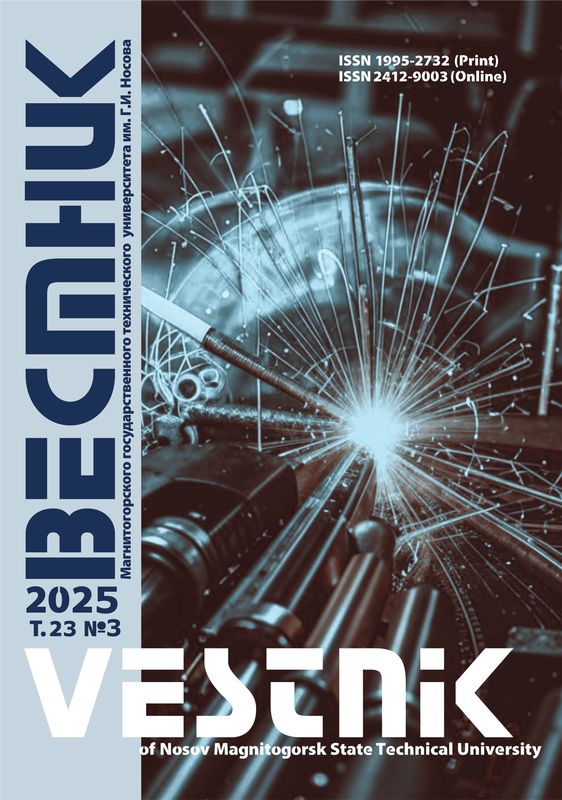DOI: 10.18503/1995-2732-2023-21-4-164-175
Abstract
When beneficiating valuable minerals, rock failing to meet the required quality is rejected. Downstream processing of such wastes by dispersing contributes to their fullest utilization in other industries. Today, the mineral separation process is achieved by step-by-step crushing only, and conventional methods do not ensure homogeneity of dispersed particles. This is explained by the fact that such rocks have a complex triaxial stress state, and the destruction during dispersion can occur along either the layering planes, or the planes with a critical value of stress combinations, characteristic of a given mineral. An anisotropic structure of the medium can be transversal and orthotropic with its characteristic topological patterns of stress tensors. Therefore, a different competing fracture mechanism is desirable for each type of medium texture during dispersion. Since anisotropic materials have no predictability in the formation of a “grid” of cracks, it is impossible to control the size of dispersed particles, when using conventional dispersing methods. Real solid bodies always contain a system of spatial micro- and macro-defects statically distributed in the body mass and partially extending to its surface. Such defects have high mobility and are capable of coagulation and annihilation due to thermal motion of molecules and mechanical stresses. Consequently, the process of deformation of the body is reduced to an increase in the size and number of macro- and micro-defects. A new concept of dimensional dispersion of brittle media is justified by increasing the volumetric geometric homogeneity of the resulting dispersed particles. This can be achieved by integrated controlled vibration introduced into the material fracture zone as forced amplitude-modulated vibrations of the working body of a cone crusher for a simultaneous formation of an extensive network of deep and surface cracks. This approach of crack formation control results in achieving quasi-homogeneity of the dispersed product at a time, and homogeneous crushed particles contribute to applying a voxel (selective) principle of stacking dispersed particles used in composites, as they are more closely stacked.
Keywords
dispersing, brittle materials, modulating vibration drives, homogeneity control, production of dispersed materials, energy-saving machines
For citation
Sergeev Yu.S., Platov S.I., Guzeev V.I., Sergeev S.V. Application of Vibration Drives with Modulating Properties in Crushers of Brittle Materials to Control the Fractional Composition of the Dispersed Phase. Vestnik Magnitogorskogo Gosudarstvennogo Tekhnicheskogo Universiteta im. G.I. Nosova [Vestnik of Nosov Magnitogorsk State Technical University]. 2023, vol. 21, no. 4, pp. 164-175. https://doi.org/10.18503/1995-2732-2023-21-4-164-175
1. Sagdeeva G.S., Patrakova G.R. Processing of production and consumption waste using their resource potential. Vestnik Kazanskogo tekhnologicheskogo universiteta [Herald of Kazan Technological University]. 2014;17(6):194-198. (In Russ.)
2. Ivanova I.A., Kolodyazhny S.A., Manokhin M.V. The problem of analysis of environmental threat criteria on asphalt concrete plants. Scientific Israel Technological Advantages. 2012;(2):44-50.
3. Pershin G.D., Ulyakov M.S., Pshenichnaya E.G., Gabbasov B.M. An energy method for calculating performance of diamond wire machines used for excavating facing stone. Vestnik Magnitogorskogo gosudarstvennogo tekhnicheskogo universiteta im. G.I. Nosova [Vestnik of Nosov Magnitogorsk State Technical University]. 2016;14(2):18-24. (In Russ.) DOI: 10.18503/1995-2732-2016-14-2-18-24
4. Song T.-H., Lee S.-H., Kim B. Recycling of crushed stone powder as a partial replacement for silica powder in extruded cement panels. Construction and Building Materials. 2014;52:105-115. DOI: 10.1016/ j.conbuildmat. 2013.10.060
5. Blekhman I.I. Chto mozhet vibratsiya? O «vibratsionnoy mekhanike» i vibratsionnoy tekhnike [What can vibration do? “Vibration mechanics” and vibration technology]. Moscow: Nauka, 1988, 208 p. (In Russ.)
6. Sergeev Yu.S., Sergeev S.V., Dyakonov A.A. Increasing geometric homogeneity of dispersed particles of plastic materials produced by vibration assisted micro-cutting. Espacios. 2017;38(48):36.
7. Singh M., Samadhiya N.K., Kumar A., Kurnar V., Singh B. A nonlinear criterion for triaxial strength of inherently anisotropic rocks. Rock Mechanics and Rock Engineering. 2015;48(4):1387-1405. DOI: 10.1007/s00603-015-0708-z
8. Rebinder P.A., Shchukin E.D. Surface phenomena in solids in the processes of their deformation and destruction. Uspekhi fizicheskikh nauk [Advances in Physical Sciences]. 1972;108(9):3-42. (In Russ.)
9. Kuzbakov Zh.I., Pershin G.D., Kolga A.D. Study on vibrations of the drive device of a jaw crusher. Vestnik Magnitogorskogo gosudarstvennogo tekhnicheskogo universiteta im. G.I. Nosova [Vestnik of Nosov Magnitogorsk State Technical University]. 2017;15(4):73-80. (In Russ.) DOI: 10.18503/1995-2732-2017-15-4-73-80
10. Khodakov G.S. Fizika izmelcheniya [Physics of grinding]. Moscow: Nauka, 1972, 307 p. (In Russ.)
11. Sergeev S.V., Zakirov R.G. Inertial rotary vibrational drives for crushers of brittle materials. Russian Engineering Research. 2012;32(2):130-134. DOI: 10.3103/ S1068798X1202027X
12. Sergeev Yu.S., Sergeev S.V., et al. Sposob vozbuzhdeniya kolebaniy [Method of excitation of vibrations]. Patent RU, no. 2533743, 2014.
13. Sergeev Yu.S., Sergeev S.V., Dyakonov A.A., Kononistov A.V., Karpov G.E., Mikryukov A.A. Automated monitoring system for self-synchronizing vibration drives. Russian Engineering Research. 2018;38(2):86-90. DOI: 10.3103/S1068798X18020168












